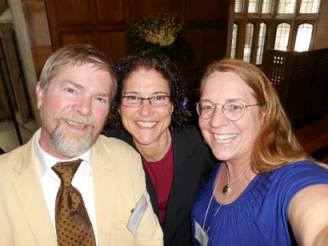Source Monitoring & False Memory
 At Marcia Johnson's Festschrift with two favorite colleagues, Linda Henkel and Steve Lindsay
At Marcia Johnson's Festschrift with two favorite colleagues, Linda Henkel and Steve LindsayYou see things, hear descriptions of other things, watch fictionalized films, and have dreams. Your life sometimes depends on your ability to determine whether a memory is "real" and whether you can trust its contents. Given that memories differ so much in their age, completeness, modality, sensibility, and other features, you must be able to use whatever is available when making source decisions.
We've found that people use a variety of memory features
to make source monitoring decisions. For example, they can
base their decision about whether they have encountered an
object by evaluating their memory for shape information.
If, for example, a pumpkin was seen previously, people are
at increased risk for mistakenly believing that they'd seen a basketball,
which shares many of the pumpkin's physical features.
In a series of studies examining various
features that could be brought to bear
in source decisions, we have found that people use not only
physical information, but also category, identity, linguistic
label, perspective-based schematic information, social inferences, cross-modal perceptual cues, and
statistical covariation in source monitoring. Although these
classes of information may differ in their salience or
diagnosticity, they all normally provide a rational means
for determining source, and so decisions based upon their
use should lead to high accuracy under normal circumstances. We've also shown the influence of a systematic but irrational influence
on source monitoring: the imposition of one's desires and emotional biases
on source monitoring decisions, with a single wish capable of distorting an entire database
of otherwise independent memories. These risks for error can have important real-world implications.
